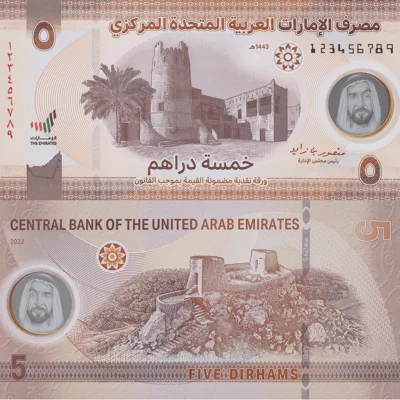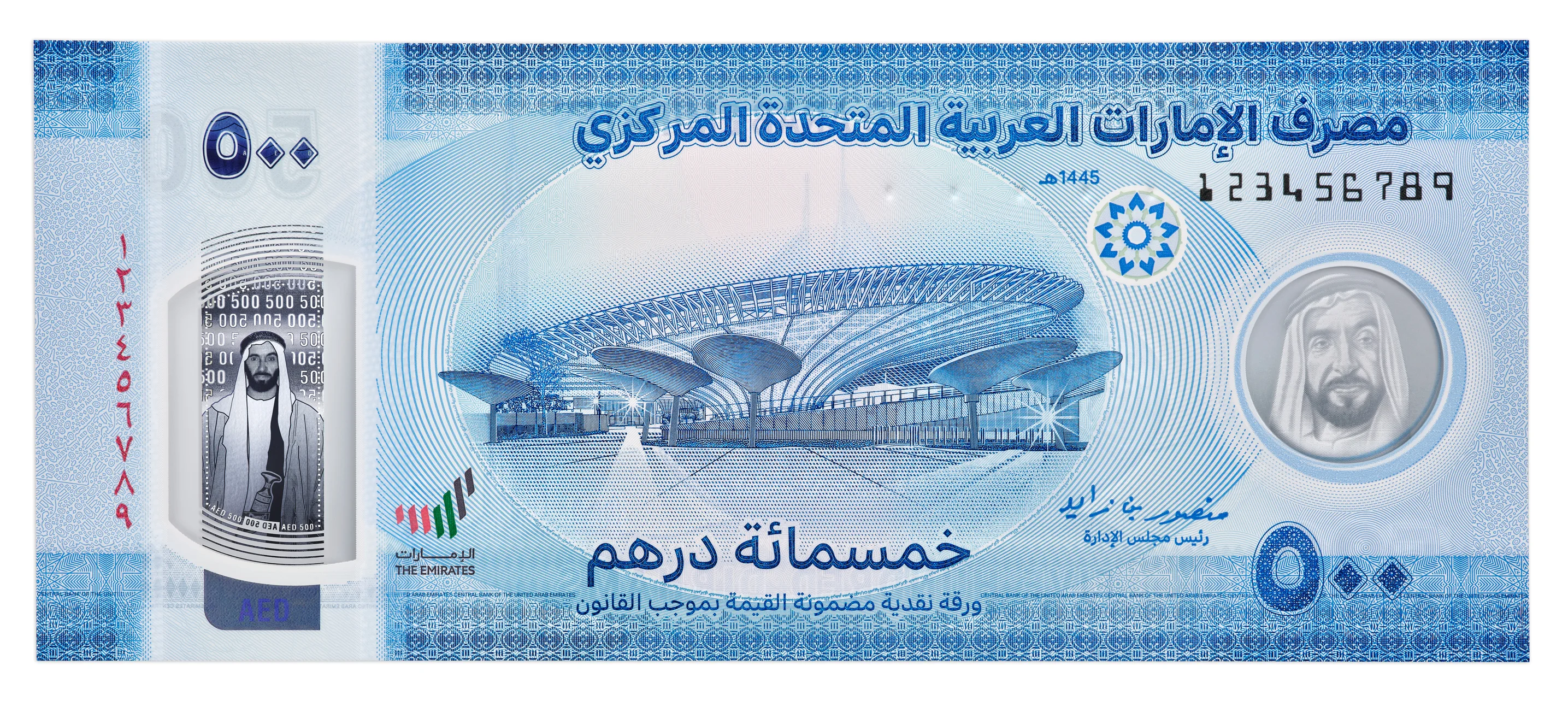
Currency manager: Central Bank of the UAE
New polymer series includes exceptional design and security; should cut environmental footprint

In 2019, the Central Bank of the UAE initiated significant plans to upgrade its banknotes, which has resulted in the issuance of five new denominations on polymer to date.
The new banknotes were issued following comprehensive benchmarking studies with other central banks, including with those in Australia and the UK, which pioneered polymer notes. The studies led the CBUAE to conclude that a polymer substrate lasts longer, stays cleaner, is more secure and has a lower carbon footprint than traditional cotton-based banknotes, which still account for the bulk of bank notes by volume globally.
The path to polymer
As a result, a new 50 dirham ($13.60) polymer banknote was released as part of the United Arab Emirates’ golden jubilee celebrations in December 2021. The 5 and 10 dirham banknotes were released in April 2022 during Eid, the Muslim religious festival during which many children are gifted new banknotes. A 1,000 dirham banknote was released in December 2022, coinciding with the UAE’s 51st national day, and designed to highlight pioneering efforts of the nation. Then, in 2023, coinciding with the UAE’s hosting of COP 28, a 500 dirham banknote was issued with the design encapsulating the UAE’s journey in sustainability.

The UAE’s new polymer banknotes are printed in the UAE by Oumolat Security Printing, using De La Rue’s Safeguard polymer substrate, with the design managed by Crane Currency.
Saif Al Dhaheri, assistant governor for banking operations and support services at the CBUAE, listed a key benefit of polymer notes as being their durability. The central bank estimates that its polymer notes will last approximately five to seven years, which is three to four times longer than its textile notes. The polymer notes are also more sustainable than their traditional cotton counterparts because of their durability and recyclability.
The CBUAE does currently recycle existing paper notes, which remain in circulation with no deadline to be retired. And some of these old cotton notes have been provided to local artists, who have been encouraged to enter competitions to make artwork from the old notes, some of which is displayed at the central bank’s headquarters. But the new polymer notes are expected to improve sustainability efforts and to reduce carbon emissions.
Safe and sound
Although the UAE is a major crossroads for trade and commerce, it has yet to encounter significant problems with counterfeiting. Nonetheless, the polymer notes are viewed as much safer.
The new 1,000 dirham polymer banknote, for example, includes Spark Flow Dimension optical features developed by Koenig & Bauer. These are being used for the first time globally for a mainstream note, the CBUAE says. In addition, the UAE notes have the largest surface-applied, multi-colour Kinegram aluminium stripe in the Middle East and north Africa region. The foil’s prominent width of 14mm and sophisticated Kinegram Colors technology, which exhibits non-holographic visual security effects, improve counterfeit resistance.
National identity
In designing the new polymer banknotes, the CBUAE used the opportunity to reflect the UAE’s national story and identity. All banknotes include images from the seven emirates that comprise the UAE. The 50 dirham banknotes features the seven founding fathers on the front of the banknotes, and an image of the late founder Sheikh Zayed bin Sultan Al Nahyan signing the union agreement is featured on the obverse.
The central bank selected noteworthy dates on which to release new denominations, which also helped to develop confidence in the new polymer notes, while showcasing cutting-edge features on the banknotes as part of the UAE’s efforts to develop futuristic technology.

For the 1,000 dirham banknote, the image of an Emirati astronaut has been added as a security feature, highlighting the country’s efforts in space exploration and academia. The front of the note also has an image of the UAE founding father, Sheikh Zayed, next to a model space shuttle, which represents his meeting with space pioneers who helped to inspire the Emirati space programme. The note includes an image of the Emirates Mars Mission’s Hope Probe. The obverse of the note includes an image of a Barakah nuclear power plant in Abu Dhabi, representing the UAE’s efforts to diversify away from hydrocarbons.
The latest 500 dirham denomination, released in November 2023, to coincide with the UAE COP28, has a blue-and-white design, reflecting culture, tourism and sustainability. The front features an image of the Terra Sustainability Pavilion – a net-zero structure in terms of energy and water usage. The reverse side features images of the Emirati Museum of the Future, along with an image of the Emirates Towers and the Burj Khalifa, all of which are prominent landmarks in the Emirate of Dubai.
Underlining the CBUAE’s commitment to inclusivity, the entire banknote series also contains tactile marks to enable the visually impaired to distinguish the various denominations from each other.
Next steps
The CBUAE has yet to finish its journey to polymer, with a 100 dirham note expected moving forwards. Meanwhile, the central bank is continuing to collect data to determine accurate measurements of the new banknotes’ carbon footprint to better inform its sustainability efforts.
The Central Banking Awards 2024 were written by Christopher Jeffery, Daniel Hinge, Dan Hardie, Joasia Popowicz, Ben Margulies, Riley Steward, Jimmy Choi and Blake Evans-Pritchard.
Only users who have a paid subscription or are part of a corporate subscription are able to print or copy content.
To access these options, along with all other subscription benefits, please contact info@centralbanking.com or view our subscription options here: subscriptions.centralbanking.com/subscribe
You are currently unable to print this content. Please contact info@centralbanking.com to find out more.
You are currently unable to copy this content. Please contact info@centralbanking.com to find out more.
Copyright Infopro Digital Limited. All rights reserved.
As outlined in our terms and conditions, https://www.infopro-digital.com/terms-and-conditions/subscriptions/ (point 2.4), printing is limited to a single copy.
If you would like to purchase additional rights please email info@centralbanking.com test test test
Copyright Infopro Digital Limited. All rights reserved.
You may share this content using our article tools. As outlined in our terms and conditions, https://www.infopro-digital.com/terms-and-conditions/subscriptions/ (clause 2.4), an Authorised User may only make one copy of the materials for their own personal use. You must also comply with the restrictions in clause 2.5.
If you would like to purchase additional rights please email info@centralbanking.com test test test




